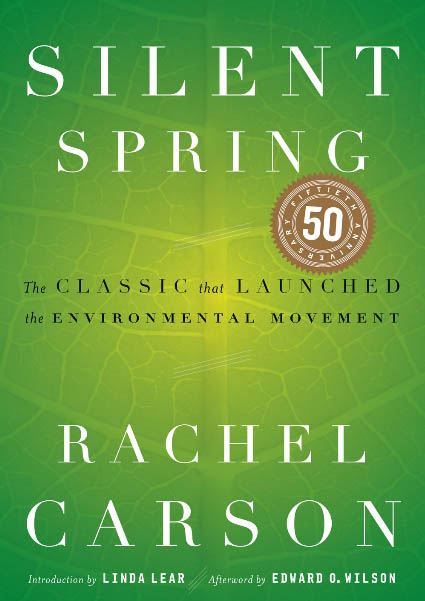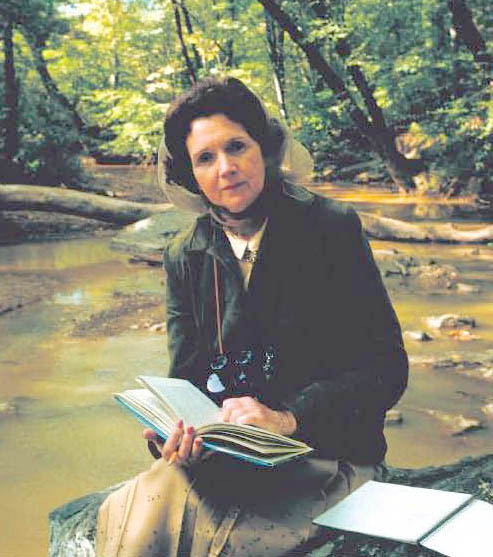 |
Home |
Catalogs |
Contact Us |

Books on:
Animal RightsBlack History
Clean Energy
Democracy
Eco Design
Eco History
Food and Nutrition
Genetic Engineering
Green Cities
Green Politics
Local Economics
Natural Building
Peace and Nonviolence
Simple Living
Trees and Forests
 |
Silent Spring
by Rachel Carson
Houghton Mifflin, 2002, Anniversary Edition, Paperback, 400 pages, Introduction by Linda
Lear, Afterword by E.O. Wilson
Purchase
on Amazon.com
One of the most influential books of our time, Silent Spring was published in 1962. It was serialized in the New Yorker in June 1962, and published in book form later that year by Houghton Mifflin.
Beautifully written, the book exposed the destruction of wildlife through the widespread use of pesticides. Despite the attacks on the book by the chemical industry, Silent Spring was widely read—especially after its selection by the Book-of-the-Month Club and the New York Times best-seller list. It inspired widespread public concerns with pesticides and pollution of the environment and is often credited with sparking the environmental movement in the United States.
2012 is the 50th anniversary of the publication of this great book. Looking around us at the few wisps of birds remaining in our skies, the dwindling number of fish in the seas, the undercutting and lack of enforcement of our environmental laws and the huge increases in health problems resulting from man-made chemicals in our environment, we see that an understanding of the message of Silent Spring is as urgent today as it was in 1962.
This is a book from which many still have a great deal to learn.
Praise for Silent Spring
"We have ignored Carson’s findings to our peril." — Joseph Mangano and Janette Sherman, Rachel Carson's Brave, Groundbreaking 'Silent Spring' at 50 Years
"The cornerstone of the new environmentalism . . . well crafted, fearless, and succinct."
— Peter Matthiessen
"Silent Spring delivered a galvanic jolt to public consciousness and, as a result, infused the environmental movement with new substance and meaning." — Edward O. Wilson from the Afterword.
"It is hard to remember the cultural climate that greeted Silent Spring and to understand the fury that was launched against its quietly determined author. Carson's thesis that we were subjecting ourselves to slow poisoning by the misuse of chemical pesticides that polluted the environment may seem like common currency now, but in 1962 Silent Spring contained the kernel of social revolution. . . . We are a nation still debating the questions it raised, still unresolved as to how to act for the common good, how to achieve environmental justice. In arguing that public health and the environment, human and natural, are inseparable, Rachel Carson insisted that the role of the expert had to be limited by democratic access and must include public debate about the risks of hazardous technologies." — Linda Lear from the Introduction.
"Rachel Carson's Silent Spring played a large role in articulating ecology as a 'subversive subject'— as a perspective that cut against the grain of materialism, scientism, and the technologically engineered control of nature. " — Professor Gary Kroll in Reflections.
Silent Spring has been featured in many lists of the best nonfiction books of the twentieth century. In the Modern Library List of Best 20th-Century Nonfiction it was at #5, and it was at #78 in the conservative National Review. Most recently, Silent Spring was named one of the 25 greatest science books of all time by the editors of Discover Magazine.
Quotes from Silent Spring
"We stand now where two roads diverge. But unlike the roads in Robert Frost's familiar poem, they are not equally fair. The road we have long been traveling is deceptively easy, a smooth superhighway on which we progress with great speed, but at its end lies disaster. The other fork of the road—the one less traveled by—offers our last, our only chance to reach a destination that assures the preservation of the earth."
. . .
"It took hundreds of millions of years to produce the life that now inhabits the earth—eons of time in which that developing and evolving and diversifying life reached a state of adjustment and balance with its surroundings. The environment, rigorously shaping and directing the life it supported, contained elements that were jhostile as well as supporting. Certain rocks gave out dangerous radiation; even with the light of the sun, from which all life draws its energy, there were short-wave radiations with power to injure. Given time--time not in years but in millennia--life adjusts, and a balance has been reached. for time is the essential ingredient; but in the modern world there is no time.
"The rapidity of change and the spped with which new situations are created follow the impetuous and heedless pace of man rather than the deliberate pace of nature. Radiation is no longer merely the background radiation of rocks, the bombardment of cosmic rays, the ultraviolet of the sun that have existed before there was any life on earth; radiation is now the unnatural creation of man's tampering with the atom. The chemicals to which life is asked to make its adjustment are no longer merely the calcium and silica and copper and all the rest of the minerals washed out of the rocks and carried in rivers to the sea; they are the synthetic creations of man's inventive mind, brewed in his laboratories, and having no courterparts in nature.
To adjust to these chemicals would require time on the scale that is nature's; it would require not merely the years of a man's life but the life of generations. And even this, ere it by some miracle possible, would be futile, for the new chemicals come from our laboratories in an endless stream; almost five hundred annually find their way into actual use in the United States alone. The figure is staggering and its implications are not easily grasped—500 new chemicals to which the bodies of men and animals are required somehow to adapt each year, chemicals totally outside the limits of biologic experience.
Among them are many that are used in man's war against nature. . . . These sprays, dusts, and aerosols are now applied almost universally to farms, gardens, forests, and homes — nonselective chemicals that have the power to kill every insect, the “good” and the “bad,” to still the song of birds and the leaping of fish in the streams, to coat the leaves with a deadly film, and to linger on in soil — all this though the intended target may be only a few weeds or insects. Can anyone believe it is possible to lay down such a barrage of poisons on the surface of the earth without making it unfit for all life? They should not be called “insecticides,” but “biocides.”
"The whole process of spraying seems caught up in an endless spiral. Since DDT was released for civilian use, a process of escalation has been going on in which ever more toxic materials must be found. This has happened because insects, in a triumphant vindication of Darwin's principle of the survival of the fittest, have evolved super races immune to the particular insecticide used, hence a deadlier one has always to be developed—and then a deadlier one than that. It has happened also because, for reasons to be described later, destructive insects often undergo a "flareback." or resurgence, after spraying, in numbers greater than before. Thus the chemical war is never won, and all life is caught in its violent crossfire.
"Along with the possibility of the extinction of mankind by nuclear war, the central problem of our age has therefore become the contamination of man's total environment with such substances of incredible potential for harm—substances that accumulate in the tissues of plants and animals and even penetrate the germ cells to shatter or alter the very material of heredity upon which the shape of the future depends. . . .
"All this has been risked—for what? Future historians may well be amazed by our distorted sense of proportion. How could intelligent beings seek to control a few unwanted species by a method that contaminated the entire environment and brought the threat of disease and death even to their own kind?"
. . .
"No witchcraft, no enemy action had silenced the rebirth of new life in this stricken world. The people had done it themselves."
. . .
"It is an extraordinary fact that the deliberate introduction of poisons into a reservoir is becoming a fairly common practice. The purpose is usually to promote recreational uses, even though the water must be treated at some expense to make it fit for its intended use as drinking water. When sportsmen of an area want to “improve” fishing in a reservoir, they prevail on authorities to dump quantities of poison into it to kill the undesired fish, which are then replaced with hatchery fish more suited to the sportsmen’s taste. The procedure has a strange Alice-in-Wonderland quality. The reservoir was created as a public water supply, yet the community, probably unconsulted about the sportsmen’s project, is forced either to drink water containing poisonous residues or to pay our tax money for treatment of the water to remove the poisons — treatments that are by no means foolproof.
. . .
"If the Bill of Rights contains no guarantee that a citizen shall be secure against lethal poisons distributed either by private individuals or by public officials, it is surely only because our forefathers, despite their considerable wisdom and foresight, could conceive of no such problem.
. . .
"There is still very limited awareness of the nature of the threat. This is an era of specialists, each of whom sees his own problem and is unaware of or intolerant of the larger frame into which it fits. It is also an era dominated by industry, in which the right to make a dollar at whatever cost is seldom challenged. When the public protests, confronted with some obvious evidence of damaging results of pesticide applications, it is fed little tranquilizing pills of half truth. We urgently need an end to these false assurances, to the sugar coating of unpalatable facts. It is the public that is being asked to assume the risks that the insect controllers calculate. The public must decide whether it wishes to continue on the present road, and it can do so only when in full possession of the facts. In the words of Jean Rostand, “The obligation to endure gives us the right to know.”
Table of Contents
- A Fable for Tomorrow
- The Obligation to Endure
- Elixirs of Death
- Surface Waters and Underground Seas
- Realms of the Soil
- Earth's Green Mantle
- Needless Havoc
- And No Birds Sing
- Rivers of Death
- Indiscriminately from the Skies
- Beyond the Dreams of the Borgias
- The Human Price
- Through a Narrow Window
- One in Every Four
- Nature Fights Back
- The Rumblings of an Avalanche
- The Other Road
Reader Comments |
